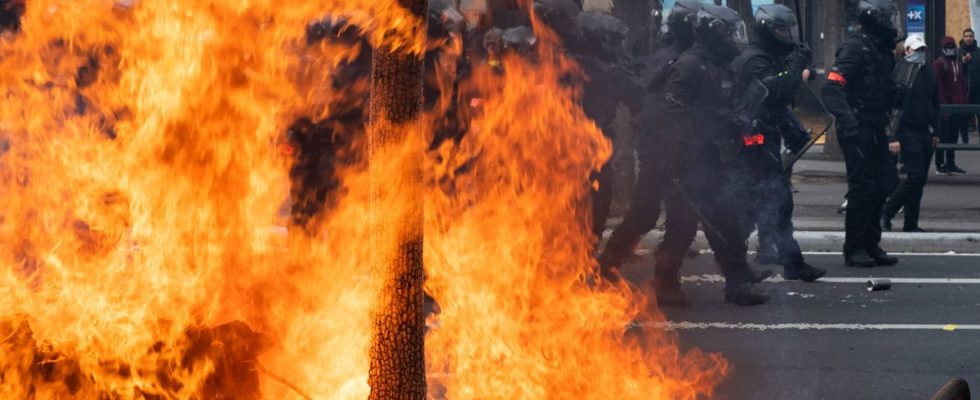Its agents did not represent, on Tuesday, not even 2% of the staff hired to secure the Parisian demonstration against the pension reform. However, they have been the subject of particular attention. It must be said that lately, the controversies have multiplied around the Brav-M, the brigade for the repression of motorized violent action. In question: several cases of police violence attributed to these police officers easily recognizable by their black outfits and their motorcycle helmets. Videos of this officer knocking out a protester with a punch, or of this other rolling over a young man’s leg, have gone viral on social media. And the sound recordings of racist threats and insults uttered to a small group of detainees caused a reaction at the highest level of the state.
If since its creation in March 2019 – shortly after the start of the “yellow vests” crisis – the Brav-M has never had good press with the demonstrators, this disenchantment seems to have reached its climax. A petition calling for the disbanding of this brigade collected more than 170,000 signatures in five days. Its authors denounce “violent and brutal exactions” which “contribute to the increase in tensions”. Above all, they draw a parallel with the Voltigeurs, an ultra-violent motorcycle unit, dissolved after the involvement of three agents in the death of Malik Ousekine in 1986.
A different Voltigeurs doctrine
“It is not because they travel on motorcycles that the doctrine is the same”, notes sociologist Mathieu Zagrodzki, researcher at the Center for Sociological Studies on Law and Penal Institutions (Cesdip). If the Voltigeurs could intervene directly from their moving machine and disperse the demonstrators with truncheons, for the Brav-M, “the motorbike is a means of transport, to get quickly to a place where overflows are reported, and not a method of intervention”, specifies the researcher. The Brav-Ms work as a duo: the pilot is responsible for dropping off his partner – the “operator” – at the scene of the intervention. The latter then carries out the mission on foot. “By comparing them to the Voltigeurs, we play on the trauma,” supports Linda Kebbab, national delegate of the Unit-SGP Police union. And to insist: “The Brav-M is just a section of an intervention company that travels on motorcycles to be more mobile in the crowd. »
How then to explain such a bad reputation? Even the Council of Europe’s human rights commissioner was moved by the excessive use of force during the latest demonstrations. Should we see a magnifying glass effect, amplified by viral videos, or is there a form of brutality inherent in the operation of this brigade which has less than a hundred crews? “The mandate of the Brav-M is offensive, recalls Mathieu Zagrodski. It is an ultra-mobile unit that was created to contact ultra-mobile groups. The unit is mainly deployed in the event of overflows, when the procession “tense up”. The agents intervene when urban violence is observed or in support of units in difficulty. They are then responsible for carrying out dispersal actions or arrests. “They go where the CRS and the mobile gendarmes, which are large rather static units, with heavy equipment and vehicles, struggle to go”, specifies the sociologist.
“Insurrectionary climate”
If the Brav-Ms were relatively discreet at the start of the mobilization against the pension reform, the use of 49.3 radically changed the configuration of the demonstrations. Monday, the day before the day of mobilization, the Ministry of the Interior announced to expect the presence of 1,000 “radical elements”, some of whom could come from abroad. “What we saw last Thursday was an increase in volume of this black bloc, an increase in radicalism”, for his part pointed out the prefect of police of Paris, Laurent Nuñez, on France Inter, denouncing the will of some “to create an insurrectionary climate”. “The response of the Brav-M is proportionate to the acts they are confronted with, insists Linda Kebbab. We cannot ask to de-escalate in the face of people who set fire to buildings, throw molotov cocktails. »
What about the cases of violence that have made headlines in recent days? From TV set and radio studio, the prefect of police repeats the same speech: the behavior of some should not cast shame on an entire unit. But for some, these overflows are also partly explained by the autonomy enjoyed by the Brav-M. “The agents work on orders, they go where the command room tells them to go, specifies Mathieu Zagrodski. But once there, they are on the initiative. However, this is a fundamental difference with the CRS and the mobile gendarmes, whose hierarchy is on the ground and can therefore not only adapt the maneuvers to the reality on the ground, but also exercise a power of control.
However, and despite the controversies, the Paris police chief has repeatedly reaffirmed this last week: a dissolution, or even a reorganization of this unit, is not on the agenda. Tuesday morning, at the microphone of France Inter, Laurent Nuñez even warned that “from now on” he intended to take legal action for any remarks that he deemed insulting to this brigade.

